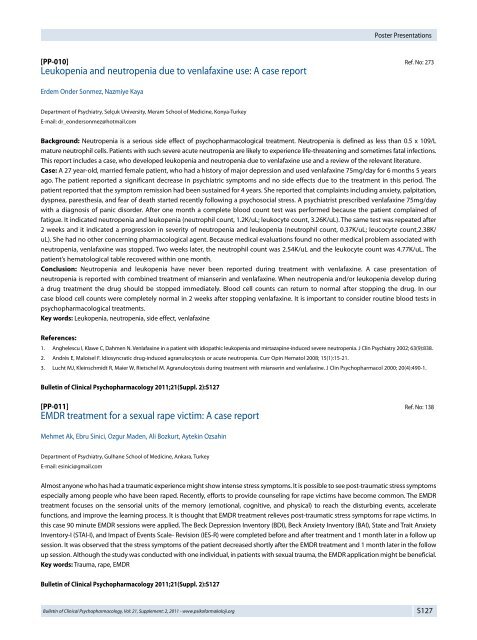SYMPOSIA
SYMPOSIA
SYMPOSIA
You also want an ePaper? Increase the reach of your titles
YUMPU automatically turns print PDFs into web optimized ePapers that Google loves.
Bulletin of Clinical Psychopharmacology, Vol: 21, Supplement: 2, 2011 - www.psikofarmakoloji.org<br />
Poster Presentations<br />
[PP-010] Ref. No: 273<br />
Leukopenia and neutropenia due to venlafaxine use: A case report<br />
Erdem Onder Sonmez, Nazmiye Kaya<br />
Department of Psychiatry, Selçuk University, Meram School of Medicine, Konya-Turkey<br />
E-mail: dr_eondersonmez@hotmail.com<br />
Background: Neutropenia is a serious side effect of psychopharmacological treatment. Neutropenia is defined as less than 0.5 x 109/L<br />
mature neutrophil cells. Patients with such severe acute neutropenia are likely to experience life-threatening and sometimes fatal infections.<br />
This report includes a case, who developed leukopenia and neutropenia due to venlafaxine use and a review of the relevant literature.<br />
Case: A 27 year-old, married female patient, who had a history of major depression and used venlafaxine 75mg/day for 6 months 5 years<br />
ago. The patient reported a significant decrease in psychiatric symptoms and no side effects due to the treatment in this period. The<br />
patient reported that the symptom remission had been sustained for 4 years. She reported that complaints including anxiety, palpitation,<br />
dyspnea, paresthesia, and fear of death started recently following a psychosocial stress. A psychiatrist prescribed venlafaxine 75mg/day<br />
with a diagnosis of panic disorder. After one month a complete blood count test was performed because the patient complained of<br />
fatigue. It indicated neutropenia and leukopenia (neutrophil count, 1.2K/uL; leukocyte count, 3.26K/uL). The same test was repeated after<br />
2 weeks and it indicated a progression in severity of neutropenia and leukopenia (neutrophil count, 0.37K/uL; leucocyte count,2.38K/<br />
uL). She had no other concerning pharmacological agent. Because medical evaluations found no other medical problem associated with<br />
neutropenia, venlafaxine was stopped. Two weeks later, the neutrophil count was 2.54K/uL and the leukocyte count was 4.77K/uL. The<br />
patient’s hematological table recovered within one month.<br />
Conclusion: Neutropenia and leukopenia have never been reported during treatment with venlafaxine. A case presentation of<br />
neutropenia is reported with combined treatment of mianserin and venlafaxine. When neutropenia and/or leukopenia develop during<br />
a drug treatment the drug should be stopped immediately. Blood cell counts can return to normal after stopping the drug. In our<br />
case blood cell counts were completely normal in 2 weeks after stopping venlafaxine. It is important to consider routine blood tests in<br />
psychopharmacological treatments.<br />
Key words: Leukopenia, neutropenia, side effect, venlafaxine<br />
References:<br />
1. Anghelescu I, Klawe C, Dahmen N. Venlafaxine in a patient with idiopathic leukopenia and mirtazapine-induced severe neutropenia. J Clin Psychiatry 2002; 63(9):838.<br />
2. Andrès E, Maloisel F. Idiosyncratic drug-induced agranulocytosis or acute neutropenia. Curr Opin Hematol 2008; 15(1):15-21.<br />
3. Lucht MJ, Kleinschmidt R, Maier W, Rietschel M. Agranulocytosis during treatment with mianserin and venlafaxine. J Clin Psychopharmacol 2000; 20(4):490-1.<br />
Bulletin of Clinical Psychopharmacology 2011;21(Suppl. 2):S127<br />
[PP-011] Ref. No: 138<br />
EMDR treatment for a sexual rape victim: A case report<br />
Mehmet Ak, Ebru Sinici, Ozgur Maden, Ali Bozkurt, Aytekin Ozsahin<br />
Department of Psychiatry, Gulhane School of Medicine, Ankara, Turkey<br />
E-mail: esinici@gmail.com<br />
Almost anyone who has had a traumatic experience might show intense stress symptoms. It is possible to see post-traumatic stress symptoms<br />
especially among people who have been raped. Recently, efforts to provide counseling for rape victims have become common. The EMDR<br />
treatment focuses on the sensorial units of the memory (emotional, cognitive, and physical) to reach the disturbing events, accelerate<br />
functions, and improve the learning process. It is thought that EMDR treatment relieves post-traumatic stress symptoms for rape victims. In<br />
this case 90 minute EMDR sessions were applied. The Beck Depression Inventory (BDI), Beck Anxiety Inventory (BAI), State and Trait Anxiety<br />
Inventory-I (STAI-I), and Impact of Events Scale- Revision (IES-R) were completed before and after treatment and 1 month later in a follow up<br />
session. It was observed that the stress symptoms of the patient decreased shortly after the EMDR treatment and 1 month later in the follow<br />
up session. Although the study was conducted with one individual, in patients with sexual trauma, the EMDR application might be beneficial.<br />
Key words: Trauma, rape, EMDR<br />
Bulletin of Clinical Psychopharmacology 2011;21(Suppl. 2):S127<br />
S127



